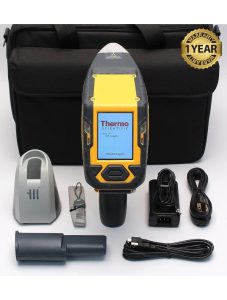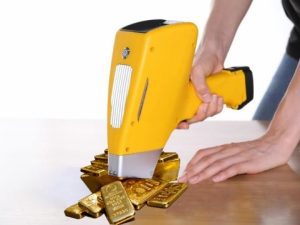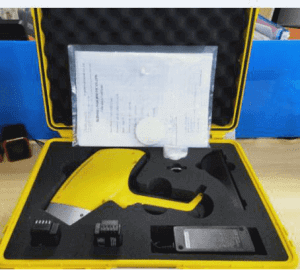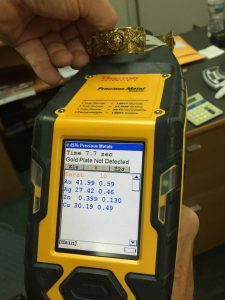Gold Testing Methods
Determining the authenticity of your Gold will ensure it has the exact value you expect, whether you’re expanding your collection, keeping a treasured heirloom, buying gold or planning to resell.
Depending on the amount of precious metals and the form they’re in, some assays can be more efficient than others. We specialize in several types of assays, or testing methods.





XRF Assay
XRF (X-ray fluorescence) analysis is a highly advanced method that can identify a vast range of elements quickly and efficiently.
It’s one of the best gold-testing solutions today, thanks to its portability, precision, and ultra-fast results.
For this gold purity verification, XRF analyzers use an X-ray source to analyze metal compositions.
- XRF analyzers are state-of-the-art electronic devices that provide the highest accuracy and precision within seconds.
- They can accurately detect real gold and measure metal content without causing any damage.
- They can identify unwanted impurities.
- XRF analyzers are available in portable, handheld designs.
Acid Testing
The acid test for gold has been used by jewelers, refiners, and other precious metal professionals for centuries. We use this acid testing method for small pieces or lots of precious metal.
It uses a nitric acid solution to evaluate gold karat purity. Pure gold resists corrosion and tarnish despite exposure to most acids. Nitric acid is harsh on false gold, especially copper-based alloys. With the nitric acid test, you’re simply testing the purity of a small scratch mark. They typically have multiple testing solutions in easy-to-squeeze bottles to help you appraise different gold karats, including 10k, 14k, 18k, and 22k gold.
Fire Assay or Melt Test
Fire assays are the standard for valuing gold and silver at major mining companies and refineries. In the process, metal is melted down, then the precious metal sample is chemically separated from the other metals. The process is different for each precious metal, using a variety of chemicals during the separation process. Because the lead is so dense, it sinks to the bottom of the mold, where it is chipped off and placed into a cupel and melted again. The cupel absorbs the lead, leaving only precious metal behind. The precious metal is then measured against the size of the rest of the sample to determine its overall purity.
Magnet Test
Pure gold, notated as 24k in the karat system, is not magnetic metal. That means using a strong magnet can help reveal gold authenticity. Neodymium magnets are the most powerful magnets for testing real gold. Key chain magnets are perfect if you want something that conveniently fits in your pocket. Note: Some counterfeits contain other metals that can be non-magnetic, leading to false results. For example, copper is not a magnetic metal.
Ultrasound Assay
This assay type uses ultrasound to measure changes in the consistency of a specific material. Unlike other assay methods, an ultrasound assay is non-destructive and does not require melting, which makes it perfect for determining whether an item is precious metal-plated—without damaging it. Ultrasonic waves travel through any medium in the same direction until they meet a different material, which causes them to reflect back to their source. The transducer detects any changes in the ultrasonic pulse to find out if the outside and inside of an object are made of the same material. If the consistency of the metal changes, so does the frequency.
Vinegar Test
Vinegar is a mildly corrosive liquid that can damage false gold. Create a tiny scratch on your gold.
Apply a few drops of white vinegar onto the scratch using a liquid dropper. Wait for 10 to 15 minutes.
Rinse your gold jewelry under running water, and then dry it with a soft cloth.
If gold is real, it will retain its lustrous sheen, whereas imitation gold will react and change color.
Note: Some counterfeits contain higher-quality metals that may not react to vinegar.